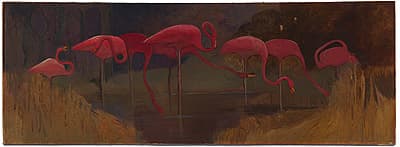
Sydney
LONG
Australia
1871
–
London
1955
England, Europe 1910-21; Australia 1921- 22; England 1922-25; Australia 1925-52; England from 1952
34.0 (h) x 96.2 (w) cm
No inscriptions National Gallery of Australia, Canberra NGA 1975.52 Purchased 1975 Reproduced with the kind permission of the Ophthalmic Research Institute of Australia
In this version of Flamingoes, Long stylised elements of the work, creating a surface flatness and arranging the long necks of the birds so they twist with serpentine grace across the frieze-like composition. And he depicted trees behind the flamingoes in an Art Nouveau fashion.
This is one of two versions of Flamingoes Long painted in about 1905, both as wedding presents. This painting, a gift from Long to a Mr and Mrs Drew, was intended to be placed over the mantelpiece in their home. The verdant background and the tranquil water Long depicted in Flamingoes 1902 (cat 18) remain, but the nudes have gone and the flamingoes (still painted in crimson) are now the focus of the composition.
Flamingoes search for food in shallow waters: they introduce their bill into the water, tilted upside down, and move their heads from side to side. When feeding, the tongue of the bird works like a pump, sucking in water and mud through the front side of the bill. The lower jaw is made from erectile tissue that confers stability, as the birds remain with their heads upside down underwater to suck up food.
In this version of Flamingoes, Long stylised elements of the work, creating a surface flatness and arranging the long necks of the birds so they twist with serpentine grace across the frieze-like composition. And he depicted trees behind the flamingoes in an Art Nouveau fashion.
This is one of two versions of Flamingoes Long painted in about 1905, both as wedding presents. This painting, a gift from Long to a Mr and Mrs Drew, was intended to be placed over the mantelpiece in their home. The verdant background and the tranquil water Long depicted in Flamingoes 1902 (cat 18) remain, but the nudes have gone and the flamingoes (still painted in crimson) are now the focus of the composition.
Flamingoes search for food in shallow waters: they introduce their bill into the water, tilted upside down, and move their heads from side to side. When feeding, the tongue of the bird works like a pump, sucking in water and mud through the front side of the bill. The lower jaw is made from erectile tissue that confers stability, as the birds remain with their heads upside down underwater to suck up food.
In this version of Flamingoes, Long stylised elements of the work, creating a surface flatness and arranging the long necks of the birds so they twist with serpentine grace across the frieze-like composition. And he depicted trees behind the flamingoes in an Art Nouveau fashion.
This is one of two versions of Flamingoes Long painted in about 1905, both as wedding presents. This painting, a gift from Long to a Mr and Mrs Drew, was intended to be placed over the mantelpiece in their home. The verdant background and the tranquil water Long depicted in Flamingoes 1902 (cat 18) remain, but the nudes have gone and the flamingoes (still painted in crimson) are now the focus of the composition.
Flamingoes search for food in shallow waters: they introduce their bill into the water, tilted upside down, and move their heads from side to side. When feeding, the tongue of the bird works like a pump, sucking in water and mud through the front side of the bill. The lower jaw is made from erectile tissue that confers stability, as the birds remain with their heads upside down underwater to suck up food.
